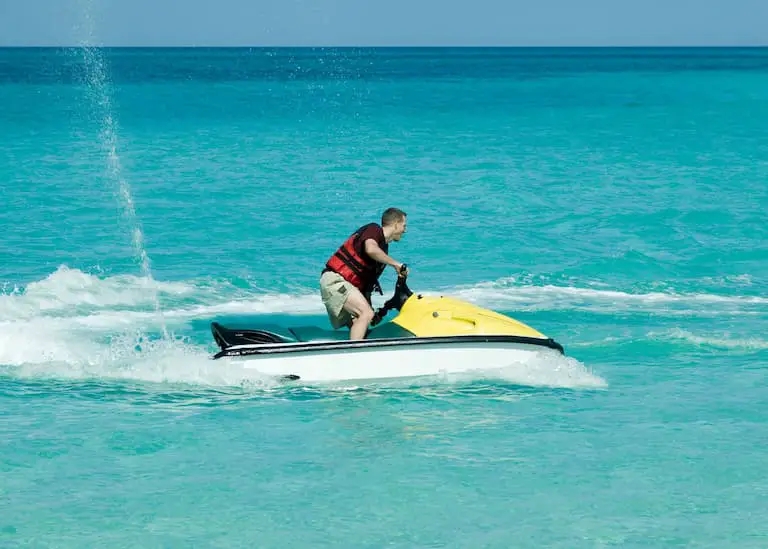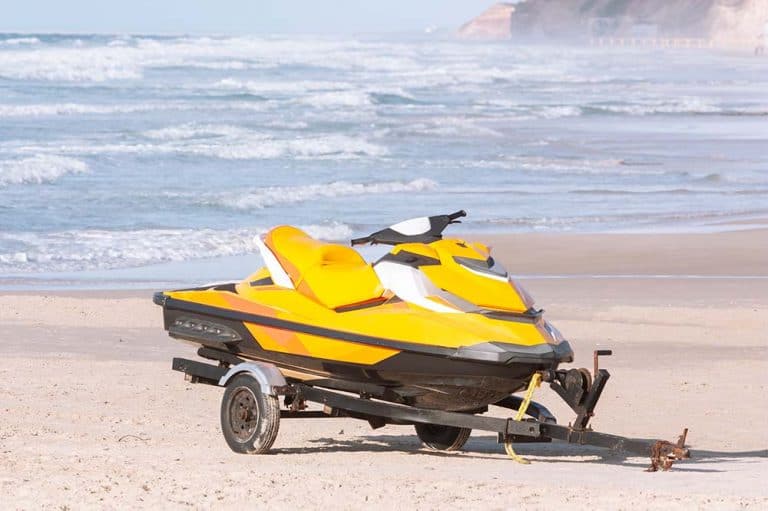2-Stroke vs. 4-Stroke Jet Ski: Which Is a Better Option?
The two-stroke and four-stroke engine options are arguably the most talked-about jet ski technology ever. And a lot of it has to do with the debate of which is a better choice.
Four-stroke jet skis are known for their fuel efficiency and low emissions. They use one part of fuel for every four strokes, while two-strokes use one part of fuel for every two strokes. This difference dictates performance, pollution levels, and fuel efficiency.
If you are on the fence about whether to get a jet ski with a 2-stroke or 4-stroke engine, this article should help make up your mind. We’ll compare these two types of personal watercraft (PWC) engines and see which comes out on top.

Differences Between the Two-Stroke and Four-Stroke Jet Ski Engines
The most notable difference between the two-stroke and four-stroke jet ski engines is the RPM. Two-stroke engines pump out a higher RPM than four-stroke engines. This is because they have a smaller displacement and need to work harder to produce the same power.
So, you won’t win any races on a four-stroke jet ski, but you will have a more pleasurable experience cruising around on one. The two-stroke engine offers more power and speed, but it’s also louder and far less fuel-efficient.
The good news is that four-stroke jet ski engines are more durable than two-stroke engines. This is because the four-stroke engine doesn’t have to work as hard to produce power, so it doesn’t put as much stress on the motor’s parts.
Furthermore, four-stroke jet skis are a lot heavier than those with a two-stroke engine. That’s because two-stroke engines have fewer metal parts, so they’re lighter.
The option you choose will come down to your needs and wants.
4-Stroke Jet Ski
If you’re looking for a fuel-efficient option that emits less pollution, is quieter, and is more reliable, then the four-stroke jet ski is likely the better option for you.

Pros of a 4-Stroke Jet Ski
- Fuel-efficient
- Fewer emissions
- More durable
Cons of a 4-Stroke Jet Ski
- More expensive than two-stroke PWC’s
- RPMs are lower than two-stroke jet skis
2-Stroke Jet Ski
If you’re looking for a fast, powerful craft that isn’t as heavy, then the two-stroke jet ski is the better option for you.
Pros of a 2-Stroke Jet Ski
- More power
- More speed
- Lighter
Cons of a 2-Stroke Jet Ski
- Noise
- Pollution
- Less fuel-efficient than four-stroke jet skis
- Less reliable
How Many Hours Will a Two-Stroke Jet Ski Last?
A well-built two-stroke jet ski should last you around 200-300 hours of riding time. This is assuming that you are using high-quality fuel and that you are taking care of your Jetski.

The maintenance routine for a jet ski or PWC is similar to that of a motorcycle. You’ll need to change the oil, the spark plugs, and the air filter after every few hours of riding time. It’s also a good idea to flush the fuel system every 50 hours to prevent build-up.
You can also choose to take the jet ski to a mechanic to have it serviced. This will cost you around $100-200 every few hundred hours of riding time. However, you’ll have the peace of mind that your jet ski is in good shape.
How Many Hours Will a 4-Stroke Jet Ski Last?
A 4-stroke jet-ski engine will last you around 300-500 hours of riding time. Compared to the two-stroke jet ski, which will only last you about 200-300 hours of riding time.
You’ll also need to add more oil to the two-stroke jet ski engine (in a 2-stroke engine the oil is added directly to the fuel), while the four-stroke jet ski is good for about 100 hours.
Additionally, the maintenance routine of these two engines is similar, yet the air filter and spark plugs take longer in the four-stroke jet ski.
Speed Difference Between 2-Stroke and 4-Stroke Jet Ski
To get a good idea of the difference between these two engines, you can think of the four-stroke engine as a Prius, while the two-stroke motor is a Ferrari. The Prius is more fuel-efficient and emits less pollution, while the Ferrari is faster and more powerful.
This video shows a two-stroke vs. four-stroke jet ski drag race, and it’s evident that the two-stroke is significantly faster:
The four-stroke doesn’t have the oomph to keep up, and it’s also quieter considering the competition.
Still, the four-stroke is the more popular option because it’s more reliable and family-friendly. But it can be too boring for some people. And that’s why the two-stroke jet ski exists – to make things more exciting.
How To Make a 4-Stroke Jet Ski Faster
An ECU reflash can make your four-stroke jet ski engine run more like a two-stroke engine. It will give you more power and speed, but it will also be noisier and less fuel-efficient. This is an excellent option if you want to race your jet ski or just have more fun on the water.
Upgrading your impeller/wear ring can also make your four-stroke jet ski run faster. This is a less expensive option than a reflash, and most dealers or service centers can do it.
People have also had great success with air intake upgrade kits. These kits can give you more power and better fuel economy. So they are a good option if you want to make your four-stroke jet ski faster without spending a lot of money.
Engine mods are another way to make your four-stroke jet ski faster. You can add a turbocharger or change the camshafts and pistons to get more power. This is a more expensive option, but it can increase your speed and performance on the water.
Final Thoughts
If you’re looking for a fast, powerful jet ski that isn’t as heavy, or you can’t stand the thought of being stuck with a slow four-stroke, then the two-stroke wave runner is the better option for you.
If you’re looking for a laid-back jet ski experience with less noise and emissions, go for the four-stroke jet ski. This is a perfect choice if you have kids, or if reliability is the determining factor when choosing watercraft.
Both options have pros and cons, yet it ultimately comes down to doing your research to find the best jet ski for your needs!







